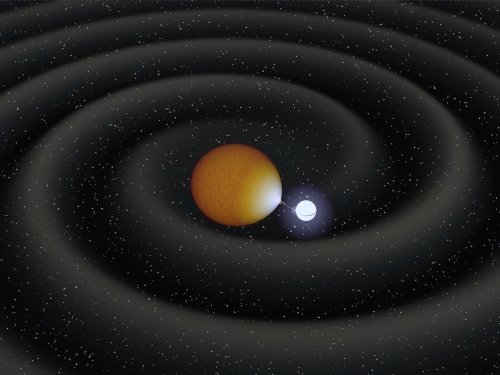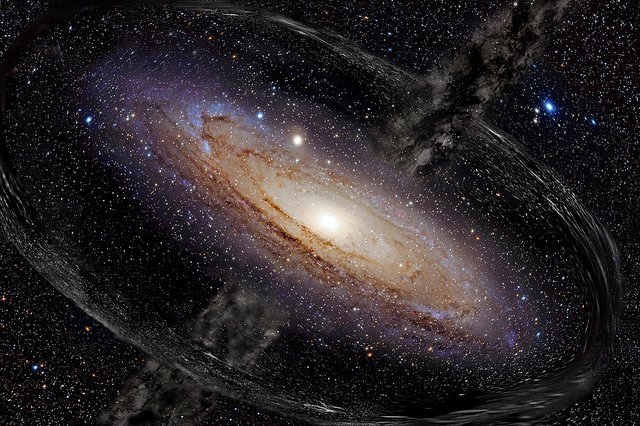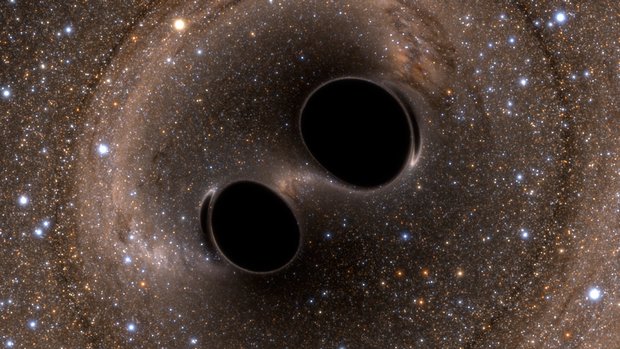Tackling new phenomena with gravitational waves, dark matter, antimatter and the Higgs boson
During the last five years, fundamental physics got two Nobel prizes for amazing discoveries. The first one, awarded in 2013, concerns the discovery of the Higgs boson whilst the second one, awarded in 2017, is related to the discovery of gravitational waves.
 [image credits: Caltech ]
[image credits: Caltech ] Amusingly enough, the first SteemSTEM meetup happened inside the Large Hadron Collider, the facility that discovered the Higgs boson and the second SteemSTEM meetup was organized at Virgo labs, one of the few places in the world hunting for gravitational waves.
Coincidences? Maybe ;)
In this post, I discuss an interesting publication that I have read 10-15 days ago.
The topic consists in the comprehensive study of a simplified model of dark matter. Whereas this could be seen as nothing more special than the 250 dark matter models regularly investigated, the present study reveals quite original features.
First, dark matter cosmological data can be accommodated, and the model also allows for the reproduction of Higgs boson data. Whilst this is not very original, the model also features a successful electroweak baryogenesis (i.e. the mechanism yielding the disappearance of antimatter in the early universe).
And this is where my interest was triggered. The model additionally predicts that the featured electroweak baryogenesis mechanism generates a gravitational wave imprint that could be discovered in a close future, in the experiments hunting for gravitational waves.
The study hence goes well beyond dark matter and the Higgs boson. Let’s now dig further into details!
CONNECTING DARK MATTER AND THE HIGGS BOSON
Adopting the standard model of cosmology, an important fraction of matter present in the universe is dark: it does not interact electromagnetically and has macroscopic gravitational effects.

[image credits: Maxwell Hamilton (CC BY 2.0)]
Dark matter has great cosmological advantages, which is why it plays a big role in standard cosmology.
It can for instance successfully explains why stars are moving as they do within the galaxies.
Moreover, dark matter allows us to reproduce the observed properties of the cosmic microwave background (the radiation background pervading the entire univers as a left-over from the big bang), and it as well helps to consistently describe the formation of the large-scale structures in the universe.
And the list of advantages is even longer. But let’s stop it here and move on with an important point: dark matter has not been observed so far. We consequently have some freedom when adding it to any particle physics model.
Relying on simplicity, we can take the Standard Model of particle physics and supplement it by one dark matter particle. That is however slightly too naive and one needs to add a second particle that will mediate the interactions of dark matter with the Standard Model particles.
The model investigated in the considered paper follows these guidelines. One adds a fermionic dark matter particle (all constituents of matter are fermions) and a new scalar boson that plays the role of the mediator. The rest stems from basic quantum field theory principles.
Without entering too much into the details, the mediator will mix with the Higgs boson so that we will end up with two Higgses, one being very close to the Standard Model one (with a small dark component) and one being very dark (with a small Standard-Model component).
CONSTRAINING THE MODEL
The simplistic model sketched above has 7 free parameters: the two masses of the new particles and 5 different couplings. This number is small enough to allow for deeply scanning the model parameter space in order to unravel the different types of phenomenology that could be featured.
However, not any single combination of the 7 free parameters is viable. One cannot be more crazy than what data is.
 [image credits: The US National Archives ]
[image credits: The US National Archives ] As said above, a Higgs boson that is very Standard-Model-like has been discovered at the Large Hadron Collider in 2012. Therefore, the model, in which the Higgs boson cannot conflict with the collider observations of the last decades. Its dark component must hence be small.
Moreover, one needs the right amount of dark matter to explain cosmology, and its properties must make it stealthy enough so that it has not been detected so far in all experiments seeking dark matter through its interaction with Earth.
In addition, the model features two scalar fields (the mediator and the Higgs), so that their relative configuration can change with the temperature. In other words, the way the two scalars behave does not have to be the same in the early universe (i.e. when the temperature was very large) as now (i.e. with a much colder temperature).
And this is exactly what has been imposed in the scan. Depending on the value of the 7 parameters, it exists a critical temperature at which the configuration of the two scalars changes. If this change is violent enough, it can generate the initial matter-antimatter asymmetry that explains why all antimatter is gone today. The scanning procedure imposed this to occur.
SUMMARY AND RESULTS : TOWARDS A GRAVITATIONAL WAVE KILLER SIGNAL
I have so far discussed this scientific article which I have recently read. It discusses a very simple model of dark matter that is constrained from varied angles: the Higgs boson, cosmology and the disappearance of antimatter in the universe today. The results are very interesting: there are parameter configurations in which all constraints are satisfied.

[image credits: The SXS Project (CC BY-SA 4.0)]
The next question is then the following: how to discover the model, of constrain it further. The answer lies in gravitational waves.
As above-mentioned, a matter-antimatter asymmetry (that yields the disappearance of matter today) can be produced in the early universe, but under the price of a violent change in the configuration of the two model scalar fields (the Higgs and the mediator).
Such a change actually generates a bunch of gravitational waves.
Those waves are the key for the faith of the model. After analyzing their properties, the authors of the considered paper have found that those waves could be detected in future gravitational wave experiments like LISA. Conclusive statements are thus close in time!
The path to new phenomena in particle physics is therefore more and more constrained by all sides: colliders, cosmology and gravitational waves. This hopefully will allow us to find something soon!
STEEMSTEM
SteemSTEM aims to make Steem a better place for Science, Technology, Engineering and Mathematics (STEM). For more information about the SteemSTEM project, feel free to follow @steemstem, have a look to the last news from the project, check out our new app or read our latest distilled.
Please also consider to support the project by voting for the SteemSTEM Witness (@stem.witness) or delegating to @steemstem for a ROI of 65% of our curation rewards (quick delegation links: 50SP | 100SP | 500SP | 1000SP | 5000SP | 10000SP).
We are on our way to make Steem a crucial medium for science communication, and it is still time to contribute to this effort!
Thanks for another really great article.
This is not on-topic but this is a good chance to ask.
If Higgs particles are what are responsible for mass, then they must be abundant in around a black hole singularity. Yet a singularity by definition approaches zero space. How could those Higgs bosons be accommodated? Actually, I'd think that they'd be gobbled up by the singularity. If no Higgs bosons, then no mass, hence no gravity, hence no black hole to begin with.
Head spins.

Or has this question been asked many times already by aspiring students?
Thanks for passing by and asking questions. I am always happy to answer, even if it is far from the topic (if I know the answer of course).
What is going on at the microscopic level is different from what is going on at the macroscopic one. The Higgs boson is responsible for the particle masses in the sense of it is a remnant of the mechanism yielding these particle masses.
However, all those masses are so small that gravity is negligible. And therefore, the elementary particles do not interact with macroscopic black holes gravitationally. In contrast, black holes can emit elementary objects (Hawking radiation).
If we want to move to the macroscopic level. let's start by building neutron and protons from the elementary quarks and gluons. It turns out that the largest part (>99%) of the neutron and proton masses comes from something else than their elementary constituents: the binding energy related to the strong force field. Therefore, not related at all to the Higgs boson.
I hope I answer your question clearly. Otherwise please come back to me.
Hello again. ;-)
Interesting. Gravitational waves were measured in the Lab LIGO.
But I understand that these waves are caused by accelerated massive systems.
However in your post, relate gravitational waves with elementary particles?
I clarify my native language is Spanisk. Use online translators to read your post.
SALUTATIONS DU VENEZUELA
Hi again (feel free to pass by anytime),
That is correct: the wave that have been measured for now originate from the merging of very compact and massive objects (neutron stars, black holes). The signal that is associated to the phase transition I mention (without explicitly quoting it a phase transition, but this is what it is at the end of the game) consists in wave of a different nature and thus featuring different properties. Those waves cannot be observed at LIGO because their frequency is expected to be much smaller in most of the cases. This is why we need to rely on future gravitational wave experiments that are sensitive to smaller gravitational wave frequencies as well.
PS: I wanted to write about the new system of fundamental units some time ago, but you were faster ^^
Thanks for the explanation.
From what I understand there may also be gravitational waves but at the quantum level. Interesting.... ;-)
On the new system of units, my article does not have the depth that a particular physicist could give. I'm an engineer, but from a third world country (In crisis). And I still have to finish the post on the mass and the relation with the Planck constant. It's costing me a bit of work to analyze it.
I am currently publishing things easier to try to make some money .... XD
Greetings from Venezuela
Please take your time. Taking the time to write down a good post is always better, both for the author (this is more satisfactory) and the readers (we get something more pleasant to read :) ).
Vous avez absolument raison, merci beaucoup pour vos conseils.
All for piggy money. xD
SALUTATIONS DU VENEZUELA
Greetings from Venezuela
Gravity waves are really cool. To think of a comparison to water waves, we are what is composing the water (the medium which is in motion)
Spacetime is the medium here. You can see the waves as ripples on spacetime originating from a catastrophic event.
The dark matter is one of the physics subjects that is as fascinating as it is important, especially in the explanation of the cosmos.
It helps a lot. That is not the only way, but it is in my opinion the most convincing one so far :)
That it is convincing is why it's important :)
What I meant is that some people may argue with this, as alternatives are not excluded. We need to stay open-minded, but we have the right to decide which option explaining cosmology one prefers. At the end of the day, data will tell us which one is realized in nature and which one is not ;)
I agree, in the fields of science any close-minded approach usually ends up in the dustbins of history as the possibility of it not being the best is something that will always be there. Data is emotionless and the way to go in such endeavours.
Excellent scientific information @lemouth. Thanks for sharing. Regards.
The pleasure is for me :)
Hi @lemouth!
Your post was upvoted by Utopian.io in cooperation with @steemstem - supporting knowledge, innovation and technological advancement on the Steem Blockchain.
Contribute to Open Source with utopian.io
Learn how to contribute on our website and join the new open source economy.
Want to chat? Join the Utopian Community on Discord https://discord.gg/h52nFrV
Congratulations @lemouth! You have completed the following achievement on the Steem blockchain and have been rewarded with new badge(s) :
Click here to view your Board of Honor
If you no longer want to receive notifications, reply to this comment with the word
STOPDo not miss the last post from @steemitboard: